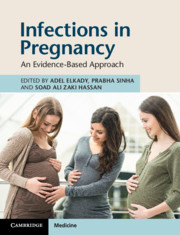Book contents
- Infections in Pregnancy
- Infections in Pregnancy
- Copyright page
- Contents
- Contributors
- Foreword
- Preface
- Section 1 Vaccination
- Section 2 Infections in Pregnancy
- Chapter 2 Viral Hepatitis
- Chapter 3 HIV Infection
- Chapter 4 Herpes Infections and Measles
- Chapter 5 Zika Virus
- Chapter 6 Parvovirus
- Chapter 7 Influenza
- Chapter 8 Cytomegalovirus
- Chapter 9 Dengue Fever
- Chapter 10 Rubella
- Chapter 11 Molluscum Contagiosum
- Chapter 12 Ebola
- Chapter 13 Chikungunya
- Chapter 14 Antibiotics during Pregnancy and Methicillin-Resistant Staphylococcus aureus (MRSA)
- Chapter 15 Gonorrhoea, Syphilis and Lymphogranuloma Venereum
- Chapter 16 Mycoplasma, Ureaplasma, Chancroid, Granuloma Inguinale (Donovanosis)
- Chapter 17 Genital Chlamydia trachomatis and Bacterial Vaginosis
- Chapter 18 Streptococcal Infection
- Chapter 19 Enterococci and Bacterial Infections
- Chapter 20 Listeriosis
- Chapter 21 Urinary Tract Infection
- Chapter 22 Infections and Preterm Labour
- Chapter 23 Appendicitis in Pregnancy
- Chapter 24 Complications Associated with Legal Termination of Pregnancy
- Chapter 25 Tuberculosis
- Chapter 26 Vulvo Vaginitis, Candida (Yeast) Infection
- Chapter 27 Malaria
- Chapter 28 Parasitic Infestation: Protozoa
- Section 3 Postpartum Infections
- Index
- References
Chapter 14 - Antibiotics during Pregnancy and Methicillin-Resistant Staphylococcus aureus (MRSA)
from Section 2 - Infections in Pregnancy
Published online by Cambridge University Press: 11 October 2019
- Infections in Pregnancy
- Infections in Pregnancy
- Copyright page
- Contents
- Contributors
- Foreword
- Preface
- Section 1 Vaccination
- Section 2 Infections in Pregnancy
- Chapter 2 Viral Hepatitis
- Chapter 3 HIV Infection
- Chapter 4 Herpes Infections and Measles
- Chapter 5 Zika Virus
- Chapter 6 Parvovirus
- Chapter 7 Influenza
- Chapter 8 Cytomegalovirus
- Chapter 9 Dengue Fever
- Chapter 10 Rubella
- Chapter 11 Molluscum Contagiosum
- Chapter 12 Ebola
- Chapter 13 Chikungunya
- Chapter 14 Antibiotics during Pregnancy and Methicillin-Resistant Staphylococcus aureus (MRSA)
- Chapter 15 Gonorrhoea, Syphilis and Lymphogranuloma Venereum
- Chapter 16 Mycoplasma, Ureaplasma, Chancroid, Granuloma Inguinale (Donovanosis)
- Chapter 17 Genital Chlamydia trachomatis and Bacterial Vaginosis
- Chapter 18 Streptococcal Infection
- Chapter 19 Enterococci and Bacterial Infections
- Chapter 20 Listeriosis
- Chapter 21 Urinary Tract Infection
- Chapter 22 Infections and Preterm Labour
- Chapter 23 Appendicitis in Pregnancy
- Chapter 24 Complications Associated with Legal Termination of Pregnancy
- Chapter 25 Tuberculosis
- Chapter 26 Vulvo Vaginitis, Candida (Yeast) Infection
- Chapter 27 Malaria
- Chapter 28 Parasitic Infestation: Protozoa
- Section 3 Postpartum Infections
- Index
- References
Summary
Antibiotics are a group of medicines used for treating infections caused by bacteria and certain parasites but are not effective against viral or fungal infection.
They are also called antibacterial or antimicrobials and work by killing the organisms or stopping them from multiplying.
Antibiotics are commonly prescribed during pregnancy; however, the specific medication must be chosen carefully as most antibiotics might be safe while some are not.
Safety depends on various factors, including the type of antibiotic, gestational age, dose and duration of the use of the antibiotics.
They are usually grouped together based on mode of action as each only works against certain types of organisms; therefore, different antibiotics are used for different infections.
- Type
- Chapter
- Information
- Infections in PregnancyAn Evidence-Based Approach, pp. 76 - 82Publisher: Cambridge University PressPrint publication year: 2019

